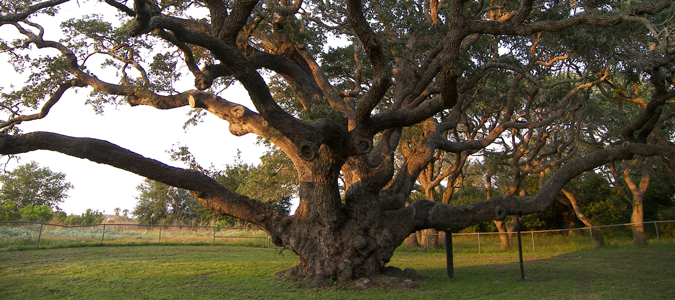
The Big Tree at Goose Island State Park north of Rockport, Texas. Photo Credit: Larry D. Moore
The Oldest Known Tree in Texas.
We’ve all marveled at different types of trees from around the world. From Redwoods in California to Banyan trees in India to Baobab trees in Madagascar, there are unique and incredibly old trees all over the world. Have you ever wondered what the oldest or most unique tree in Texas is?
The oldest tree on record in Texas is right in our neighborhood, a 1,000-year-old Coastal Live Oak nicknamed “The Big Tree”. Over its lifetime, the tree has withstood between 40 and 50 hurricanes and narrowly escaped destruction during the Civil War as Union troops set fire to the town of Lamar not far away.
Where did the Big Tree come from?
So, how did this tree, like a handful of other old trees around the world, manage to live so long? Part of the reason for the tree’s survival is its location. It sits in the middle of a group of live oak trees, which protect it from the winds of those 40-50 hurricanes it survived. The tree also sits on higher ground, so there’s less risk of its roots being drowned from the nearby Saint Charles Bay.
In 1931, Texas began gathering up land for Goose Island Park, and human intervention began to protect the tree as well. Rainfall is monitored on a monthly basis, and anything less than 2 inches of rain per month will trigger park rangers to water the tree (and possibly the fire department in severe droughts). The tree has also had help from caretakers who have trimmed branches and eradicated outside invaders like pests and fungi.
The Big Tree has lived most of its 1,000 years without human intervention. There’s definitely something to be learned from it that will increase the longevity of trees in general. As with many things in life, location is everything.
There are many characteristics of The Big Tree’s site that contribute to its long lifespan. These include higher ground, the right amount of water, the ability to spread its root system and natural protection by other structures, to name a few. The Big Tree also benefits from limited human intervention, in that people are only stepping into to maintain the tree when it is absolutely necessary.
Care for Your own Texas Trees.
How can you apply the teachings of The Big Tree to make sure the trees in your yard survive and thrive?
Here are a few tips:
- Choose a location that will allow the tree to spread out, both above and below ground. A tree planted too close to a structure will have trouble spreading its root system out to collect as much water as it needs. Trees planted too close to power lines could interfere with those lines as their branches grow and mature.
- Ensure the tree receives the right amount of water. Too much water is just as deadly as too little water. During summer months, check the area around the tree every 4 to 5 days. An easy way to measure is to insert a metal rod in the soil around the tree to a depth of 18 inches. If it comes out muddy, the tree is receiving adequate water.
- Watch trees for invasions of fungus like nectria canker, a common fungus found on oak trees, and for pests such as borers. Trim branches only as necessary. For oak trees, pruning is discouraged between February 1st and June 1st due to oak wilt.
The trees you plant in your yard today could live for many generations, just like The Big Tree. Help your tree live a long life with the right care and attention.